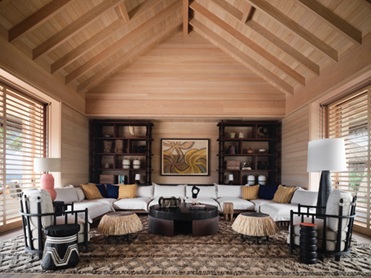
As more consumers and designers increasingly prioritize wellness, biophilic design has become a driving force in furniture manufacturing, especially within hospitality spaces. Beyond simply adding greenery, biophilic design extends to the materials and textures and is reflected in the craftsmanship that collectively shapes a space holistically.
Incorporating biophilic elements into furniture manufacturing involves utilizing responsibly sourced materials like reclaimed wood, embracing organic forms, and applying textured finishes. It’s imperative for brands to design biophilic furniture that connects to nature while minimizing environmental impact. A commitment to durable, recyclable materials ensures that sustainability is built into every piece—without compromising the client’s vision or function. Beyond the mental and physical well-being benefits, biophilic design has become a defining factor in creating wellness-driven environments that encourage guests to return.
Understanding Biophilia & Its Role in Furniture Design
Biophilia—the innate human connection to nature—has long been studied for its psychological and physiological benefits. In furniture design, incorporating biophilic principles means more than just aesthetics; it’s about reducing environmental impact and integrating nature into every aspect. Sustainable practices in furniture manufacturing, such as using reclaimed wood, non-toxic finishes, and recycled materials, align with biophilic principles. Using reclaimed wood reduces the demand for newly harvested timber, helping to combat deforestation and protect biodiversity. Traditional furniture finishes often contain volatile organic compounds (VOCs) that release harmful emissions into the air, contributing to poor indoor air quality. Recycled materials reduce the need for virgin raw materials, lowering greenhouse gas emissions and limiting landfill waste. These choices not only reduce the depletion of natural resources but also enhance overall well-being.
The Design Upside of Biophilia
The fluid and non-uniform patterns seen in nature can be used as inspiration in furnishings. Nature-inspired silhouettes, such as curved lines that mimic trees or flowing water, create a sense of organic movement within a space. Textural elements, like raw wood grains and stone finishes, create a tactile experience that connects guests with their surroundings.
Moreover, biophilic design creates balance in a room by integrating natural patterns, colors, and elements that promote comfort and tranquility. Warm wooden tones, earth-inspired hues, and natural textiles make spaces feel restorative. By emphasizing these design principles, you’re able to craft pieces that have an elevated aesthetic and contribute to a healthier environment.
Biophilia in Resort Design
The motivation behind biophilic design is to strengthen the relationship between people and nature. Today’s hospitality market values wellness for people and the planet. A significant majority of travelers prioritize sustainability in their travel choices, with 55% considering it important when traveling and 60% willing to pay more for sustainable travel services. As wellness becomes an increasing focus, travelers are seeking experiences and businesses that align with their values. This commitment to sustainability should extend to every detail of a resort or hotel space—including the furniture. The key elements of biophilic design in resorts include curved structures, natural scents, organic materials, and an earthy color palette. A prime example of this approach is the Kona Village Resort in Hawaii, where Coast to Coast Custom Furniture provided bespoke furnishings that blurred the boundaries between indoor and outdoor spaces.

After more than a decade of dormancy, Kona Village was revived on the Kailua coast. The resort epitomizes thoughtful craftsmanship with a balance between honoring traditions of the island and embracing modern form through biophilic design. The custom-made pieces were designed to be as minimally disruptive to the land as possible, harmonizing with the surroundings to create a striking yet low-impact aesthetic. Recycled and reclaimed materials from previous structures were used in the custom furnishings around the resort. Everything is a sensory experience, with woven textures layered to deepen the connection to the local land and culture. More than 30 materials, including dozens of natural fibers sourced specifically for the resort, were used in the production of the seating and casegoods.
At 1 Hotel Hanalei Bay, sustainability is also a guiding principle. Inspired by the beauty of Kaua’i North Shore, Coast to Coast Custom Furniture worked closely with the design team to create furniture that channeled the textures, materials, and finishes of Hanalei Bay and honored the local aesthetic. Every piece—from the sofas and traditional Punai daybeds to the handwoven headboards and media consoles—was custom-fabricated to reflect a balance of functionality and the overall design narrative.
The furniture emphasized natural, woven, and sustainably sourced woods, with a preference for eco-friendly and regionally appropriate materials. Sustainability carried through not only in the sourcing of materials but also in the details—down to the environmentally friendly packaging used throughout production and delivery. As with other biophilic resorts, the goal was to allow guests to experience comfort while being immersed in the rich sensory experience of the surrounding nature.
Through the intentional design of custom furniture manufacturing, nature can remain at the heart of every interior—ensuring that furniture does more than fill a space; it enhances the human experience within it. In hospitality, adopting biophilic furniture creates a 360-degree approach to well-being by fostering a deeper connection to the outdoors. This caters to the growing demand among travelers for spaces that promote wellness and relaxation.
About the Author
Doug Olson is the founder and owner of Coast to Coast Custom Furniture, a company born from his lifelong passion for exceptional design and world-class hospitality. Inspired by his extensive travels and firsthand experiences in luxury hotels and resorts, Olson launched the company in 2003 with a vision to create bespoke furniture that enhances guest experiences. His expertise in biophilic design, sustainability, and raising industry standards ensures that each piece seamlessly blends aesthetics with functionality. Under his leadership, Coast to Coast Custom Furniture has grown into a thriving business, driven by a dedicated team committed to crafting high-quality, custom furniture that transforms hospitality spaces worldwide.





